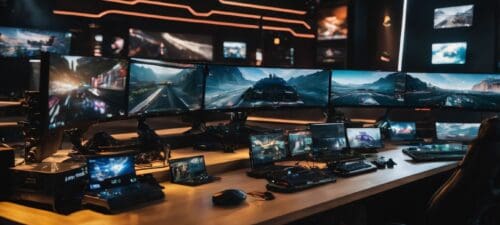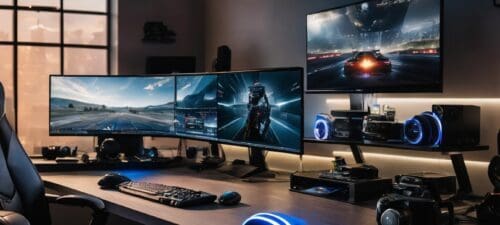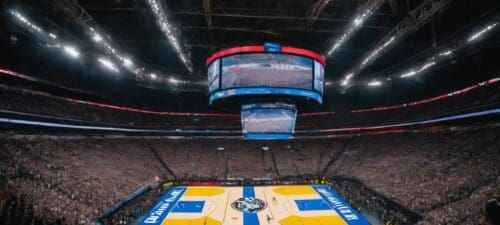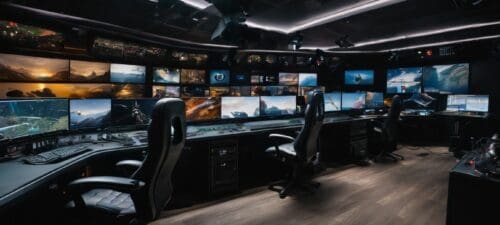Esports Graphic Design and Multimedia Careers
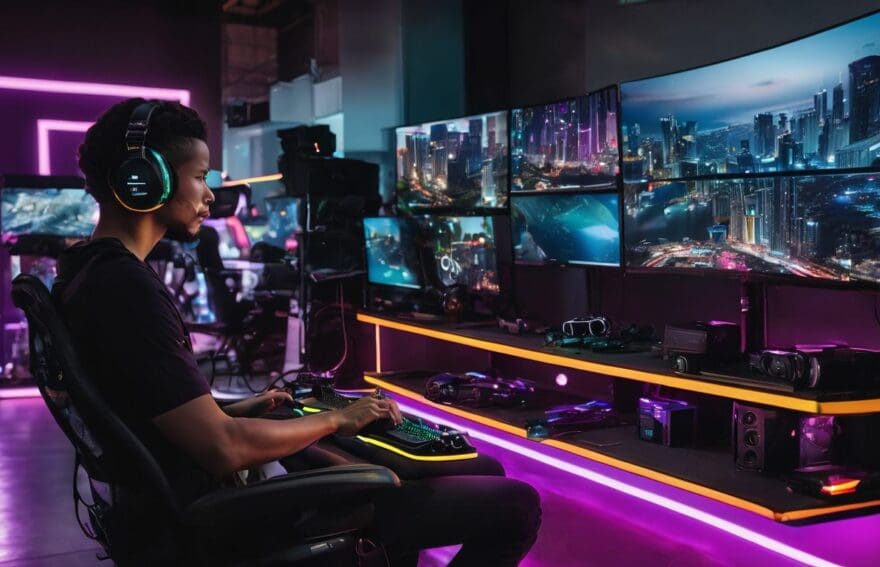
Updated On: November 08, 2025 by James Connolly
Embarking on the journey to find a career that marries your fervour for gaming with artistic flair can seem quite the formidable quest. We understand that struggle – but have you considered that the esports industry is in its heyday, currently yearning for gifted graphic designers? Our guide deftly unravels how to channel your affection for video games into a thrilling vocation within esports graphic design and multimedia.
Immerse yourself and enhance your career horizons!
The Growth of Esports and the Demand for Graphic Designers
Esports is exploding in popularity, and with that surge comes a massive need for talented graphic designers. We see job postings skyrocket as organisations scramble to find creatives who can craft compelling visual stories for their brands.
Just like traditional sports, every esports team wants to stand out with a unique identity, and that’s where we come in – bringing imagination to life on screens around the world.
As video game tournaments fill arenas, graphics play an essential role in exciting fans and keeping them engaged. Our mission becomes designing eye-catching logos, dynamic interfaces, and immersive environments that resonate with the passionate gaming community.
The demand stretches beyond mere aesthetics; it delves into creating experiences through visual communication that speaks directly to gamers’ hearts. With advancements in gaming technology, our roles are growing more complex but also more thrilling – opening doors to endless creative possibilities within this vibrant industry.
Esports Graphic Design and Multimedia Careers
Esports graphic design and multimedia careers offer a range of exciting opportunities within the gaming industry. From creating eye-catching visuals to understanding the gaming community, these roles require a unique skillset and creativity that can lead to fulfilling career paths in esports organisations.
Responsibilities and skills needed
- Creating visually stunning graphics and multimedia content tailored to the gaming community’s preferences and interests.
- Developing a deep understanding of graphic design principles, including layout, typography, colour theory, and composition.
- Collaborating with teams to ensure visual consistency across different platforms such as social media, websites, and video content.
- Proficiency in using industry – standard design software such as Adobe Creative Suite, including Photoshop, Illustrator, After Effects, and Premiere Pro.
- Keeping up with the latest trends in graphic design technology, including VR and 3D graphics, motion design, animation techniques, and application of design systems.
- Excellent time management skills to meet tight deadlines while maintaining high-quality standards for visual content production.
Opportunities in esports organizations
Esports organisations offer a range of opportunities for graphic designers and multimedia professionals. With the industry’s rapid growth, there is a high demand for skilled individuals to create captivating visual content for teams, events, and marketing campaigns.
Graphic designers in esports have the chance to work on branding, advertising materials, and user interface designs, contributing directly to the immersive gaming experience. These organisations also provide avenues for career progression and skill development within a dynamic and innovative environment.
Within esports organisations, freelance design roles are available alongside full-time positions. This flexibility allows designers to explore various projects across different gaming platforms or genres while building a diverse portfolio of work.
Importance of understanding the gaming community
Understanding the gaming community is crucial for esports graphic designers and multimedia professionals. By grasping the interests, preferences, and trends within the gaming world, we can tailor our designs to resonate with gamers, creating visually captivating content that enhances their gaming experiences.
This insight allows us to effectively communicate through visual storytelling and branding that resonates with gamers on a personal level. Moreover, understanding their culture helps in creating authentic and relatable designs that forge a deeper connection with this vibrant community of passionate players.
Recognising the nuances of the gaming community enables us to craft designs that are not just visually appealing but also meaningful and impactful for gamers across different platforms.
With this awareness, we can push boundaries in graphic design innovation that aligns with gamer expectations while driving engagement and immersion within the digital realms of esports and video games.
Advancements in Esports Graphic Design Technology
Esports graphic design technology has seen significant advancements, such as the application of VR and 3D graphics, motion design and animation, as well as the use of design systems to create innovative and engaging visuals for gamers.
Read on to discover more about the exciting world of esports graphic design careers!
VR and 3D graphics
VR and 3D graphics play a pivotal role in shaping the visual landscape of esports. These cutting-edge technologies enable designers to create immersive and realistic gaming experiences, captivating the audience with lifelike environments and dynamic visuals.
By leveraging VR and 3D graphics, multimedia designers can craft interactive elements that elevate the overall gaming experience, bringing virtual worlds to life with stunning detail and depth.
Implementing VR and 3D graphics in esports design requires a thorough understanding of technological advancements and innovative applications. Designers proficient in these areas are well-equipped to push boundaries, delivering engaging content that resonates with gamers on a visceral level.
Motion design and animation
Motion design and animation are integral parts of esports graphic design, bringing visual content to life with dynamic movement and engaging storytelling. Designers use cutting-edge tools to create stunning 2D and 3D animations that captivate audiences and enhance the gaming experience.
These skills are in high demand within the gaming industry, offering exciting career opportunities for multimedia designers looking to specialise in video game graphics. With a focus on digital arts and interactive media, motion graphics designers play a vital role in shaping the immersive worlds of esports through their creativity and technical expertise.
Esports graphic design technology has advanced significantly, allowing designers to push boundaries with VR experiences, 3D graphics, and application of design systems industry-wide.
Application of design systems
Esports graphic designers make use of design systems to ensure consistency and cohesiveness across various visual elements. These systems provide a framework for creating unified logos, colour schemes, typography, and other design components that resonate with the gaming audience.
By implementing design systems, designers can maintain a distinctive brand identity for esports teams and organisations while catering to the unique preferences of gamers. This approach allows for efficient creation of graphics tailored to different platforms, enhancing the overall engagement and recognition within the gaming community.
The application of design systems in esports graphic design also facilitates seamless collaboration among multidisciplinary teams. Designers work alongside developers, marketers, and content creators to integrate cohesive visual concepts into every aspect of the gaming experience.
Essential Tools and Resources for Esports Graphic Designers
Esports graphic designers rely on a variety of software and programs to bring their creative visions to life, as well as online communities and networking for collaboration and inspiration.
Continued education and skill development are also essential in this fast-paced industry.
Software and programs used
Esports graphic designers utilise a range of industry-standard software and programs to bring their creative visions to life. These include Adobe Creative Suite, particularly Photoshop and Illustrator for digital artwork and graphic design, as well as After Effects for motion graphics and animation.
Additionally, knowledge of 3D modelling software such as Blender or Maya can be advantageous for creating immersive gaming content. Understanding these tools is essential to stay competitive in the gaming industry.
In addition to fundamental tools like Photoshop and Illustrator, staying updated with emerging technologies such as VR platforms is crucial for designing interactive experiences within esports.
Knowledge of Unity or Unreal Engine can also empower designers in crafting visually captivating games that resonate with the gaming community.
Online communities and networking
Esports graphic designers often engage with online communities and networking to stay updated on industry trends, share their work, and connect with potential clients or employers.
Joining platforms like Discord, Reddit, and specialised gaming forums can provide valuable insights into the gaming community’s preferences and design trends. Building connections with other professionals in the industry through LinkedIn or attending esports events can lead to freelance opportunities, internships, or even full-time positions within esports organisations or game development companies.
Participating in online communities and networking allows graphic designers to showcase their portfolios, receive feedback from fellow designers and gamers, as well as gain exposure to potential job offers or projects.
Continued education and skill development
After tapping into the resources and support available in online communities and networking, it’s essential to focus on continued education and skill development. As the esports industry evolves rapidly, staying updated with emerging technologies, design trends, and multimedia tools is crucial for graphic designers.
Pursuing specialised courses or workshops in video game design, motion graphics, VR technology, or animation can enhance our skills and make us more competitive in this dynamic field.
Additionally, actively participating in gaming events and conventions can provide valuable insights into the latest developments within the gaming community. By continuously learning and adapting to new advancements in multimedia design, we can further solidify our position as sought-after professionals within the gaming industry.
Benefits and Perks of Working in Esports Graphic Design
Working in esports graphic design offers competitive salaries, flexible work schedules, and ample opportunities for growth and promotion within the industry. As the demand for talented designers continues to rise in the world of gaming, there has never been a better time to pursue a career in esports graphic design.
Competitive salaries
Esports graphic designers can benefit from competitive salaries in the gaming industry. Skilled professionals with expertise in graphic design and multimedia are highly sought after, offering them lucrative remuneration.
With roles and essential skills in high demand, video game graphic designers can secure financially rewarding opportunities that reflect their expertise and contribute to the dynamic gaming world.
Professionals pursuing careers in esports graphic design can enjoy a range of benefits, including significant earning potential. The demand for skilled designers continues to grow, creating ample opportunities for individuals seeking competitive salaries within the gaming industry.
Flexible work schedules
As esports graphic designers, we enjoy the benefit of flexible work schedules, allowing us to balance our professional and personal lives effectively. This flexibility empowers us to choose when and where we work, enabling a better work-life harmony.
It also provides an opportunity for those juggling other commitments or pursuing continued education to thrive in their careers without compromising their other responsibilities.
Moreover, freelancing opportunities within the gaming industry offer remote working options, granting us the freedom to work from anywhere while contributing to innovative projects that align with our passions.
Opportunities for growth and promotion
Video game graphic designers have diverse career paths that offer opportunities for growth and advancement. With the increasing demand for skilled professionals in this field, there are ample chances to progress within esports organisations and gaming companies.
As freelance designers or full-time employees, individuals can build their portfolios through internships and remote graphic design jobs in the gaming industry. Moreover, continued education and skill development provide avenues for personal and professional growth, ensuring a dynamic career trajectory within the realm of esports graphic design.
The thriving nature of the video game industry provides numerous pathways for career progression and promotion within esports organisations. Embracing these opportunities allows individuals to cultivate fulfilling careers while contributing to the vibrant landscape of multimedia design and gaming.
Conclusion
In conclusion, careers in esports graphic design and multimedia offer dynamic and fulfilling opportunities for skilled professionals. With the growing demand for visual content in the gaming industry, graphic designers play a critical role in creating engaging visual experiences.
The combination of creative skills, technological advancements, and understanding of the gaming community make this career path both exciting and rewarding. As esports continues to expand globally, there will be increasing opportunities for individuals passionate about graphic design to thrive in this diverse and evolving industry.
FAQs
1. What kind of jobs are there in esports graphic design?
In the world of esports, you can find jobs like digital media designer, creative designer positions, and specific roles within gaming industry graphic design.
2. Can I start my career with an internship in esports graphic design?
Absolutely! Esports graphic design internships offer a great way for newcomers to gain experience and build their portfolios in this exciting field.
3. Are there opportunities for freelance graphic designers in gaming?
Yes, the gaming industry has many freelance graphic design opportunities where you can work on projects like video game graphics and casino designs from anywhere you choose.
4. How does a career as an esports multimedia designer differ from other creative jobs?
Esports multimedia designers focus on creating dynamic visuals specifically for the competitive gaming scene, which requires staying current with both digital trends and gamer culture to create engaging content.



